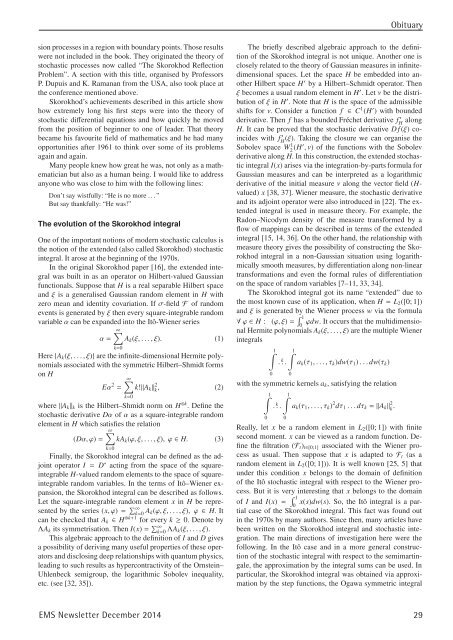2014-12-94
2014-12-94
2014-12-94
You also want an ePaper? Increase the reach of your titles
YUMPU automatically turns print PDFs into web optimized ePapers that Google loves.
Obituarysion processes in a region with boundary points. Those resultswere not included in the book. They originated the theory ofstochastic processes now called “The Skorokhod ReflectionProblem”. A section with this title, organised by ProfessorsP. Dupuis and K. Ramanan from the USA, also took place atthe conference mentioned above.Skorokhod’s achievements described in this article showhow extremely long his first steps were into the theory ofstochastic differential equations and how quickly he movedfrom the position of beginner to one of leader. That theorybecame his favourite field of mathematics and he had manyopportunities after 1961 to think over some of its problemsagain and again.Many people knew how great he was, not only as a mathematicianbut also as a human being. I would like to addressanyone who was close to him with the following lines:Don’t say wistfully: “He is no more . . . ”But say thankfully: “He was!”The evolution of the Skorokhod integralOne of the important notions of modern stochastic calculus isthe notion of the extended (also called Skorokhod) stochasticintegral. It arose at the beginning of the 1970s.In the original Skorokhod paper [16], the extended integralwas built in as an operator on Hilbert-valued Gaussianfunctionals. Suppose that H is a real separable Hilbert spaceand ξ is a generalised Gaussian random element in H withzero mean and identity covariation. If σ-field F of randomevents is generated by ξ then every square-integrable randomvariable α can be expanded into the Itô-Wiener series∞α = A k (ξ,...,ξ). (1)k=0Here {A k (ξ,...,ξ)} are the infinite-dimensional Hermite polynomialsassociated with the symmetric Hilbert–Shmidt formson H∞Eα 2 = k!A k 2 k , (2)k=0where A k k is the Hilbert–Shmidt norm on H ⊗k . Define thestochastic derivative Dα of α as a square-integrable randomelement in H which satisfies the relation∞(Dα, ϕ) = kA k (ϕ,ξ,...,ξ), ϕ∈ H. (3)k=0Finally, the Skorokhod integral can be defined as the adjointoperator I = D ∗ acting from the space of the squareintegrableH-valued random elements to the space of squareintegrablerandom variables. In the terms of Itô–Wiener expansion,the Skorokhod integral can be described as follows.Let the square-integrable random element x in H be representedby the series (x,ϕ) = ∞k=0 A k (ϕ,ξ,...,ξ), ϕ∈ H. Itcan be checked that A k ∈ H ⊗k+1 for every k ≥ 0. Denote byΛA k its symmetrisation. Then I(x) = ∞k=0 ΛA k (ξ,...,ξ).This algebraic approach to the definition of I and D givesa possibility of deriving many useful properties of these operatorsand disclosing deep relationships with quantum physics,leading to such results as hypercontractivity of the Ornstein–Uhlenbeck semigroup, the logarithmic Sobolev inequality,etc. (see [32, 35]).The briefly described algebraic approach to the definitionof the Skorokhod integral is not unique. Another one isclosely related to the theory of Gaussian measures in infinitedimensionalspaces. Let the space H be embedded into anotherHilbert space H by a Hilbert–Schmidt operator. Thenξ becomes a usual random element in H . Let ν be the distributionof ξ in H . Note that H is the space of the admissibleshifts for ν. Consider a function f ∈ C 1 (H ) with boundedderivative. Then f has a bounded Fréchet derivative fH alongH. It can be proved that the stochastic derivative Df(ξ) coincideswith fH (ξ). Taking the closure we can organise theSobolev space W2 1(H ,ν) of the functions with the Sobolevderivative along H. In this construction, the extended stochasticintegral I(x) arises via the integration-by-parts formula forGaussian measures and can be interpreted as a logarithmicderivative of the initial measure ν along the vector field (Hvalued)x [38, 37]. Wiener measure, the stochastic derivativeand its adjoint operator were also introduced in [22]. The extendedintegral is used in measure theory. For example, theRadon–Nicodym density of the measure transformed by aflow of mappings can be described in terms of the extendedintegral [15, 14, 36]. On the other hand, the relationship withmeasure theory gives the possibility of constructing the Skorokhodintegral in a non-Gaussian situation using logarithmicallysmooth measures, by differentiation along non-lineartransformations and even the formal rules of differentiationon the space of random variables [7–11, 33, 34].The Skorokhod integral got its name “extended” due tothe most known case of its application, when H = L 2 ([0; 1])and ξ is generated by the Wiener process w via the formula∀ ϕ ∈ H : (ϕ, ξ) = 1ϕdw. It occurs that the multidimensionalHermite polynomials A k (ξ,...,ξ) are the multiple Wiener0integrals 1 1...ka k (τ 1 ,...,τ k )dw(τ 1 ) ...dw(τ k )00with the symmetric kernels a k , satisfying the relation 1 1...ka k (τ 1 ,...,τ k ) 2 dτ 1 ...dτ k = A k 2 k .00Really, let x be a random element in L 2 ([0; 1]) with finitesecond moment. x can be viewed as a random function. Definethe filtration (F t ) t∈[0;1] associated with the Wiener processas usual. Then suppose that x is adapted to F t (as arandom element in L 2 ([0; 1])). It is well known [25, 5] thatunder this condition x belongs to the domain of definitionof the Itô stochastic integral with respect to the Wiener process.But it is very interesting that x belongs to the domainof I and I(x) = 1x(s)dw(s). So, the Itô integral is a partialcase of the Skorokhod integral. This fact was found out0in the 1970s by many authors. Since then, many articles havebeen written on the Skorokhod integral and stochastic integration.The main directions of investigation here were thefollowing. In the Itô case and in a more general constructionof the stochastic integral with respect to the semimartingale,the approximation by the integral sums can be used. Inparticular, the Skorokhod integral was obtained via approximationby the step functions, the Ogawa symmetric integralEMS Newsletter December <strong>2014</strong> 29


